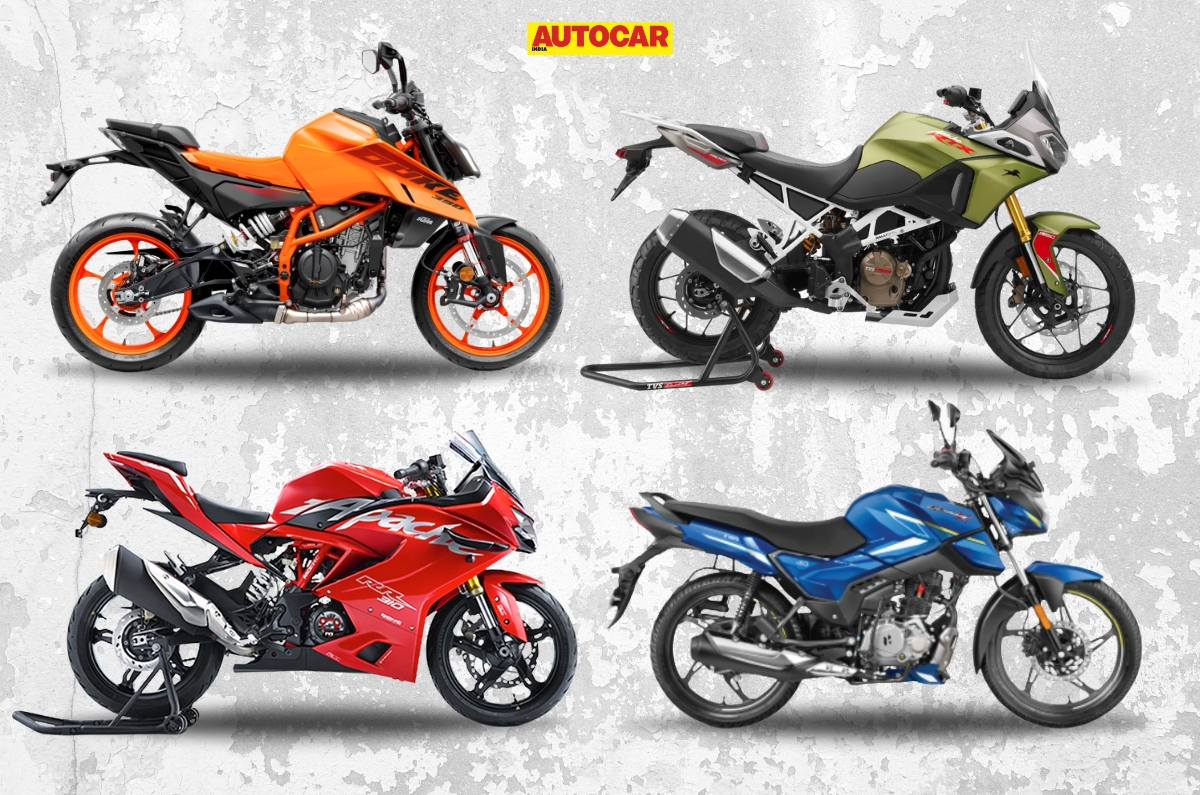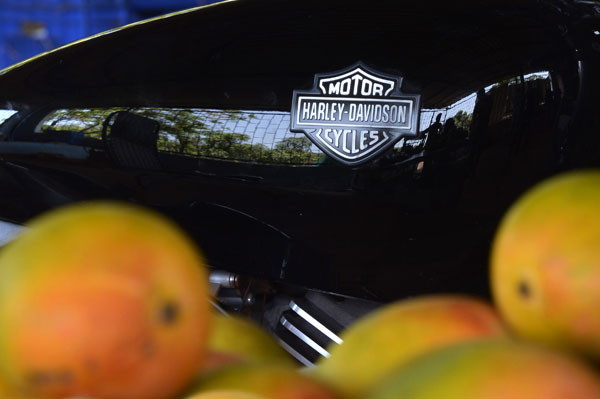Staying relevant isn’t for everyone. It surely shouldn’t be for the motorcycles you see here, having uncouthly barged into the subtly ornate confines of Jimmy Boy, a popular Parsi restaurant in the old quarter of Mumbai. Royal Enfields have never been known for their manners. In fact, until very recently, they were not known for anything pronouncedly pleasant. Yet, it won’t be far-fetched to call the Royal Enfield an absolute global sensation and one of the most successful motorcycle marques of our time. It’s almost unbelievable, that thought.
It’s one thing to stay alive, though, and entirely another to stay relevant. That’s not to belittle life itself, but to emphasise the significance of meaning. It is, after all, a life of meaning that has brought about this seemingly fantastical intrusion – one of motorcycles bringing visual mayhem into a tranquil setting, quite like you’d have seen in one of Sergio Leone’s old Westerns. Heck, one of them is even called a Bullet! And to think either gave themselves ample opportunities to evaporate from collective consciousness.
BEGINNER’S LUCK
In the late 1950s, Ardeshir Irani was a busy man, running a bustling cafe on Bank Street in Fort district of South Bombay. Hot buns generously swiped with Polson’s maska would swiftly fly out of the Cafe India kitchen, outdone only by rounds of chai, drained enthusiastically by those employed in offices in the predominantly art deco precinct. The rattle of Scandinavian chairs shifting on the tiled flooring, along with the clunk of plates carrying dry sponge cakes landing on the marble tables formed a rhythm, often accentuated by the light-footed hum of Austins and Morrises and, on occasion, the noticeably bassier Buicks and Chevys. The soundtrack of Cafe India had remained largely unchanged ever since it opened for business in 1925, except, the serving British officers had, since 1947, been replaced by a visibly ambitious and energetic demographic of cosmopolitan Bombay.
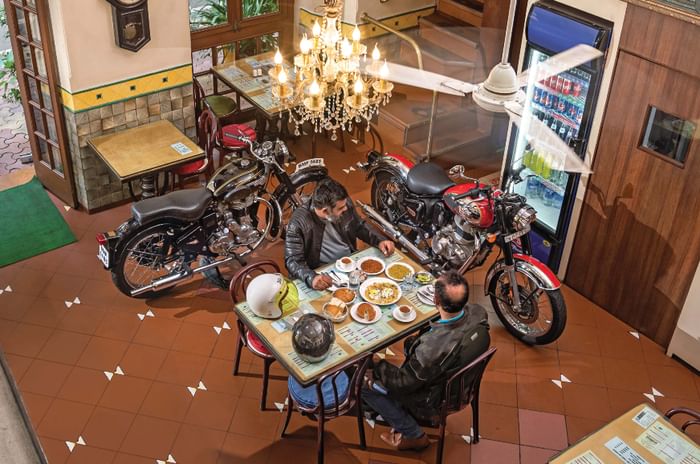
The ambition and energy wasn’t exclusive to Bombay, either. In 1958, the shinier of the two motorcycles you see here (tricky, eh?) had just rolled off a buzzing, if austere, assembly line in Thiruvottiyur, on the outskirts of erstwhile Madras. At the time, the Bullet nameplate was already a quarter of a century old and it was the radically improved third-generation model, introduced in the UK in 1949, that was assembled, and subsequently manufactured, in India. The Indian Army placed a huge order for Bullets to be used primarily as a border patrol vehicle, and contributing conveniently to its success was the simple fact that it was the only mass-built motorcycle in India at the time. The imported BSAs and Triumphs in use at the time had proven to neither be as reliable nor as inexpensive to own and maintain; the Bullet, on the other hand, was a fairly simple motorcycle, while also being quite robust and patiently engineered. It can be said, with some creative licence, that this wasn’t a hastily designed battle contraption built by people who faced the gloomy prospect of being flattened by the Luftwaffe, halfway through designing the crankcase. The Bullet was more a product of engineering finesse than a compulsion of war.
THE GOOD, THE BAD…
One such motorcycle, a black Royal Enfield Bullet, would often be seen parked outside Cafe India. It belonged to Aspi Irani, a young lad who, like his father Jamshed and grandfather Ardeshir, worked with great diligence at the family-run establishment. In later years, his Bullet, impeccably clean in a way that is so stereotypical of Parsi-owned vehicles, would ferry his wife, him and three young daughters around the breezy bylanes of Bombay, a visual that wasn’t quite alarming for its time.
Business wasn’t particularly resounding in the following decades, however, with the market – and palettes – opening up to newer, more flamboyant experiences. Cafe India was meritorious enough to have a future, but not necessarily a bright one. Then, in 1999, came Aspi’s turn to steer the legacy ahead. It wasn’t quite the fork in the road, but it appeared so to him. He saw things differently, with a depth that must have seemed preposterous, almost, and so he decided to tell a story. The story of his father, Jamshed – ‘Jimmy Boy’ to friends and family. Over two decades since, Jimmy Boy has its own identity as an atypical Parsi restaurant that doesn’t squarely fall into the ‘Irani cafe’ stereotype. It’s a place you can go to for a great meal, such as the enormous spread that lay on our table this morning.
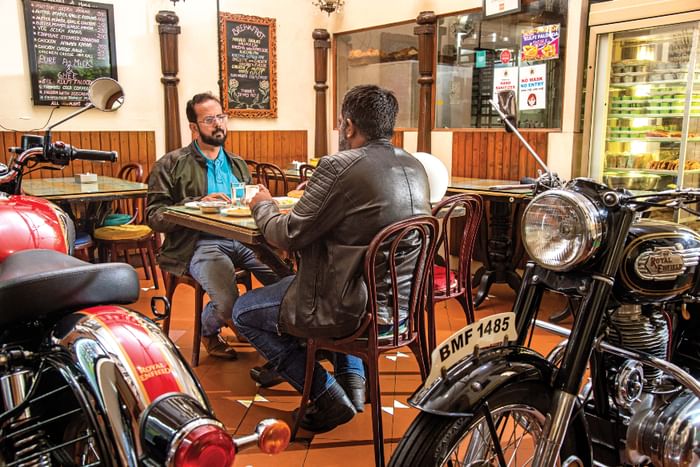
Across the table from me is Shivdutt Halady, a fine gentleman who most certainly has an irrational love of Royal Enfields and owns half a dozen of them; I am led to believe this statistic may be new to his wife. The one beside us is his oldest, and it is impossibly crisp – both, cosmetically and mechanically. Restored and maintained painstakingly by Akleem Ansari, a respected figure in classic bike circles, this ’58 Bullet makes me forget, for an embarrassingly elaborate moment, about the brand-new Classic 350 I’ve brought along! Of course, with all that delectable chrome the new Classic is laden with – and its pleasant, recently retouched lines – it’s an exceptionally beautiful motorcycle and Halady is understandably consumed by it. And to think it almost wouldn’t have existed.
In the late 1990s, and going into the early 2000s, Royal Enfield was all but a mess. In a world dominated by Honda’s sloper-engine, the Bullet’s 348cc cast iron mill, with its separate Albion 4-speed gearbox, was perfectly obsolete. With half the fuel-efficiency of the average Hero-Honda, a sliver of the performance of the Yamaha RX (also nearing the end of the road), none of the conveniences of the Kinetic-Honda DX, and a dismal aftersales experience, the Bullet was solely the reserve of the Indian alpha-male stereotype. It was a motorcycle bought primarily on characteristically Indian concepts of physics. ‘Big and bulky equals safe and stable’ being the longest-standing of these ‘scientific’ principles revered to this day. Bollywood helped a bit, too. Good guys rode Bullets, bad guys rode 2-strokes and nobody of any real cinematic consequence rode CD100s. Towards the end of the 2000s, though, even the silver screen lost its effectiveness in favour of the Bullet.
STAYIN’ ALIVE
The introduction of the unit-construction engine in 2008, a move deemed too late in the day (by about 50 years, honestly), was Royal Enfield’s ‘Jimmy Boy’ moment. It was as instantly written off by purists as it was snapped up by millions, especially when the Classic was launched a year later, its form leaving people wildly enamoured. The launch of the Classic 350 and 500 brought about a new challenge, however. For the first time ever, you had to wait to have your Royal Enfield arrive, not because the truck carrying it had turned turtle, as had frequently been the case in the past, but because it simply hadn’t been made yet!
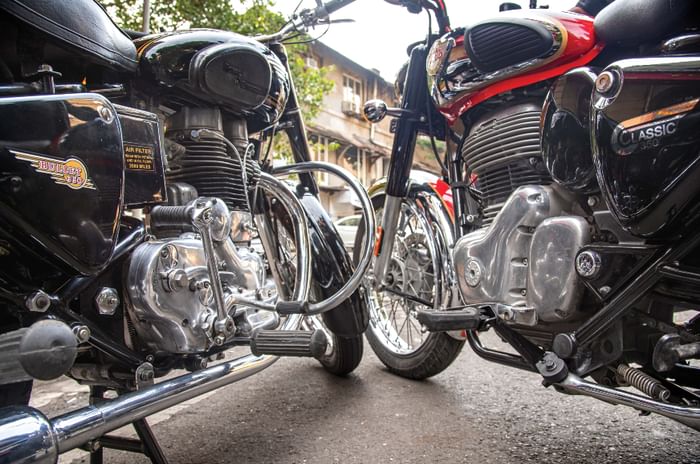
The average waiting period for a Classic 350 was about 10 months. Over a decade later, you still need to wait for about half that much time, not because demand has dwindled, but because Royal Enfield has upped its manufacturing practices significantly. To call it a success, therefore, will be telling an incomplete story. In reality, the UCE is single-handedly responsible for the revival of a brand, the livelihood of thousands and for sowing the seeds of aspiration in millions, not just in India but around the world. One engine made it all happen. The UCE was a brilliantly timed masterstroke that, to a large extent, can be credited with thumb-starting the retro motorcycle revolution around the world. It is, however, unlikely to be remembered as an engineering marvel.
Another decade later, though, the UCE has evolved beautifully. It’s now a really nice engine, pumping along gently while its muted thump – a mandatory ode to its lineage – pulsates comfortingly through the handlebar. The Classic 350 is decidedly old world in its mannerisms, and yet, entirely new age in its responses and feel. You’d struggle to find agricultural hiccups masquerading as ‘character’ and, yet, it is full of personality. The Classic is a state-of-mind-altering motorcycle that influences how you ride, but out of romanticism, rather than some form of mechanical incapability. You can do ‘normal’ motorcycle things with it, too – and it sure has the legs – but on most days, it instinctively feels more appropriate to ride it with some courtesy. I’m on the fence about that one, to be truthful, because ‘fast Bullets’, colloquially speaking, are a fearsome thrill.
A SOUND STORY
For today, though, gently following its ancestor around the empty art deco landscape feels apt – and quite like time travel, except nobody told me it was going to involve a pair of long-stroke engines. In place of a buzzing flux capacitor are two evocative heartbeats, emerging from technology separated by a century. And yet, they are distinctly identifiable as nothing but a pair of Royal Enfield motorcycles.
Indeed, the exhaust note of a Bullet was the first motorcycle sound I – and, I suspect, quite a lot of you – was able to identify. Osho, the mystic, once made a beautiful analogy with reference to an infant in the womb listening to its mother’s heartbeat. “It is the first meeting with music and rhythm, the first drum one encounters,” he had said, in one of his many meditative discourses. That probably explains why the beating heart of a Royal Enfield seems so aesthetic to many around the world. It’s a human sound, one we’ve all listened to before even being born.
To many, it may not be as soul-stirring as the haunting bawl of an RD350, or the roar of a Road King, but you will never hear a Royal Enfield and mistake it for something else. It’s the same story, if a lot less stoic, with the Classic too. Its modern SOHC engine surely lacks the gravitas of its cast-iron predecessor – or, indeed, the peppiness of some of its peers – but it still has a story to tell. A story of its own, one that will be read and heard for generations to come. As history has it, while palettes and desires will change and evolve, some even into obsoletion, it is stories that will always, always remain relevant.
We’d like to thank Nazneen Irani, Sherzad Irani, Shivdutt Halady, and Yogi Chhabria of YC Design for making this story happen.



